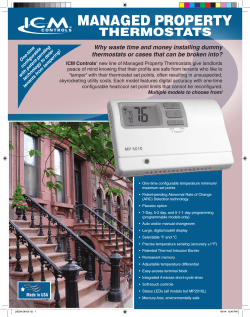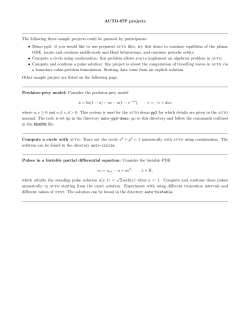
How to improve the patient care and medication management process –
How to improve the patient care and medication management process – what are we doing in Hong Kong’s public hospitals ? S C CHIANG BPharm (Hons), MRPS, MHA, FHKCHSE, FACHSE Senior Pharmacist Hospital Authority Hong Kong Email: scchiang@ha.org.hk Various departmental IT systems • Non clinical systems : – for pharmacy • Pharmaceutical Supplies System • Clinical systems : – for pharmacy • Pharmacy Management System • Express Dispensing System – for clinicians • Medication Order Entry System for out-patient Characteristics of systems • Designed & developed by users • Original primary focus – To improve operation efficiencies – To maintain uniformity & standardisation of practice • Enhanced over the years – To support policy & procedural changes • Large user base – Over 3000 clinicians – Over 100 pharmacies locations Current status • Large transaction volumes in 2008/09 – – – – In-patient & discharges (1.25 m bed days) A&E attendances (2.1 m) Specialist Out-patient clinics (7.8 m) General Out-patient clinics (5.1m) • Total reliance on the system Drug database • A centrally maintained drug data base for entire HA since 2 decades ago – 3000 drug records – Each record has over 80 fields – all items have unique in house item codes, supplier codes, manufacturer code – not GS1 standards Use of drug database • Supporting the pharmacy operations e.g. – Procurement & EDI with suppliers – Inventory management – Drug dispensing • Output from system data analysis – For monitoring drug consumption pattern • quantity & expenditure – For purchasing- & contract negotiation – For budgeting & drug utilisation review For the past 2 decades • Incremental functional changes have been made to the system & database structure • Satisfactory progress • Several major versions of software /hardware upgrades • not falling behind from the industry practice • May even be leading in some areas – Clinical Management System – ERP – eHR Medication Management • Never a simple process • Improved patient awareness & increased expectations • Cannot afford just to focus on operation efficiency • Raising the bar on patient safety • How can we achieve this ? Sources of Harm Problems in drug administration The least mitigated risks Problems with drug supply Apple Daily News 2009-04-12 WHAT IS OUR RESPONSE SO FAR? 2009/10 2010/11 2011/12 Simple Chemotherapy function IPMOE Design and Development 2012/13 2013/14 IPMOE Implementation Pilot IPMOE in PMH (IPMOE = In-Patient Medication Order Entry) IPMOE: What risks can it address? Enhanced management measures • In March 2009, HA announced 7 key initiatives to enhance HA’s pharmaceutical products procurement system 1. 2. 3. 4. 5. 6. 7. Introduce microbiology testing by manufacturers on drug products (including batch release report) Perform sample testing by HA Require suppliers to provide additional standard information for drug delivery documentation Work with DH on ease of access to drug registration details, etc. Introduce multi-source for high volume / high risk drugs Introduce bar-coding for automatic checking of order & receipt and prevention of expired items Establish a Drug Quality Assurance Office to monitor quality and oversee Enhanced management measures: What risks can they address? Product supply Chasm in the information flow Source: GS1 Both the enhanced management measures and IPMOE require the product ID Chasm in the information flow Product IDsEven are lost if dispensed as soon asdrugs they have reachAuto the pharmacy IDs, store. they are lost as soon as they go out of the pharmacy. Chasm in the information flow • Work with HK Government to make the bar code mandate ? • Work with manufacturer to require the tagging of product ID at unit-of-use level at source (manufacturer / supplier) ? • Work with IT to provide system enhancement so that the product ID can be captured & printed &by way of our normal labeling processes - Yes WHAT MORE WILL WE DO TO CROSS THIS CHASM? Medication Use Process: Examining the least-mitigated risks Clinician Pharmacy Nurse • Electronic prescribing • Decision support • Electronic MAR • Electronic MAR • Drugs dispensed are in ready-to-use form • Drugs have Auto ID • Verify patient ID + drug ID against MAR • Minimized ward stock • Minimized manual handling, esp. for IV drugs • Drugs dispensed are in ready-to-use form • Drugs have Auto ID • Automated dispensing technologies • More unit dose dispensing • Less bulk supply “Closing the loop” in the Medication Use Process Being dealt with • Involves electronic prescribing and MAR • Requires Auto ID for patients • Requires Auto ID for drugs • Requires system and process changes in the drug distribution and administration system Needs more attention Crossing the chasm – Drug Auto ID • Auto ID direct from manufacturer / supplier – As many products as possible – As many levels as possible (carton, pack, box, blister, unit-of-use) • Strengthening the drug re-packaging and dispensing processes: – Keeping track of manufacturer- and supplier-assigned Auto ID – Tagging more Auto IDs at unit-of-use level (if not already available) • System support for end-to-end Auto ID persistence: – – – – – – – From initiation of procurement… … To goods receiving .…. … To goods movement… … To re-packaging… … To dispensing… … To drug administration … To eHR Multi-level Auto IDs: Where will they come from? Hospital Supplier Will the Hospital Authority need Re-packaging centres? Source: Zuellig Pharma Section VI: Conclusions (Pharm) • Barcode Readiness (cont’) – Most of the respondents said they were currently not capable of printing barcode labels for hospitals (77.4%). – For those who are capable of printing barcode, they can provide barcode in GS1 standard (62.5%). A small fraction of them can provide GS1 barcode and other type of barcode (6.3%). But some have no idea of what barcode standard they are using (31.3%). – For those who are not capable of printing barcode, they were asked on the time required to build up barcode capability and a majority of them claimed they have no idea of how long they would need to build up the capability (67.3%) and also a high percentage of them would need more than 1 year to provide products with barcode (20%) . Auto-ID-assisted drug administration • Capture Auto ID to verify: – Patient identity – Drug identity • To ensure: – – – – – Right Patient Right Drug Right Route Right Dose Right Time Source: NHS “Coding for Success” Immediate future plans • System and process change for – Drug distribution – Drug administration Conclusion • All parties in the Supply Chain must agree with the significance and importance of the need to track and trace • All parties must commit & contribute to this ultimate objective • This is not just about efficiency in the supply management side but is also about the safety that extends to the user management side • Our goals are clear and we would need much support from every player to reach our goals
© Copyright 2025





















